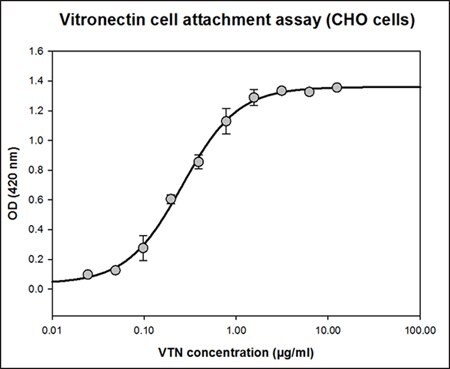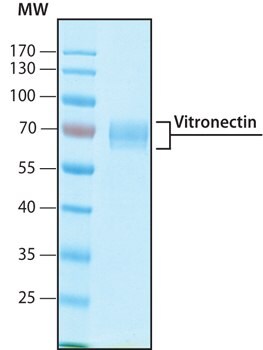Coating Tissue Culture Plates with Vitronectin
Vitronectin (Product No. SRP3186) is used to coat culture vessels for cells attachment. Below is a suggested coating protocol for a 96-well plate at a coating concentration of 0.5 µg/cm2. Note that the optimal concentration will vary with each cell line. For culture vessels other than a 96-well plate, scale this protocol accordingly. To calculate the working concentration of vitronectin, use Table 1, or the following equation:

Working concentration calculation Example:
To coat a 96-well plate (surface area is 0.3 cm2/well) at a coating concentration of 0.5 µg/cm2, prepare 9.6-10 mL of diluted vitronectin solution (0.1 mL/well × 96 wells, Table 1) at the following concentration:

The vitronectin working concentration in this example is 1.5 µg/mL. Adding 0.1 mL per well of this working solution will yield a coating concentration of 0.5 µg/cm2.


Bioassay
The biological activity of human, recombinant Vitronectin (VTN) expressed in HEK 293 cells (SRP3186) was measured in a cell attachment assay using CHO cells. The EC50 is defined as the effective concentration that elicits a 50% increase in cell attachment in a cell-based bioassay.
Materials
- 1X PBS
- Pure water (e.g.,Product No. W3500)
- Sterile tissue culture 96-well plate with a lid (Product No. CLS3300)
- Recombinant human vitronectin (Product No. SRP3186)
Protocol
A. Preparation of vitronectin
- Reconstitute the lyophilized vitronectin with sterile water, to a final concentration of 100-300 µg/mL. This stock solution can be stored at 2-8 oC for up to one week. For extended storage, it is best to further dilute in a buffer containing a carrier protein (example 0.1% BSA) and store in working aliquots at -20 to -80 oC.
- Further dilute the reconstituted vitronectin stock solution in 1X PBS to a final concentration of 1.5 µg/mL. For example, for a 10 mL solution (sufficient to coat one 96-well plate), dilute 75 µL of 200 µg/mL stock solution in 10 mL of 1X PBS.
B. Coating the plate
- To each well, add 100 µL of the 1.5 µg/mL vitronectin solution, for a final coating concentration of 0.5 µg/cm2.
- Cover the plate with a lid. For best results it is best to incubate the plate for 2 hours at 37 oC in 5% CO2 and 95% air, and then over-night at 2-8 oC.
- Aspirate the vitronectin solution, being careful not to scratch the coated vitronectin. The plate is now ready to use.
- Wash each well 3 times with 1XPBS.
- For immediate use, aspirate the 1XPBS. Alternatively, the coated plate can be stored for up to one week at 2-8 oC with 1XPBS, covered and wrapped in laboratory film.
- Before use, pre-warm the coated plate.
Materials
To continue reading please sign in or create an account.
Don't Have An Account?